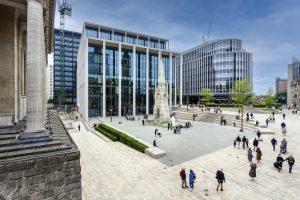Developing vacant floorspace in Greater Birmingham could pave way for 2,000 homes

Nearly 2,000 new homes could be delivered by converting vacant commercial floorspace across Birmingham and its surrounding regions, a planning and development firm has said.
The findings by planning consultancy Turley show that if 50% of vacant commercial floorspace in the Greater Birmingham and Solihull Local Enterprise Partnership area was used for residential purposes, 1,939 new homes could be created.
This figure assumes residential developments would not exceed the height of existing buildings. Adding one storey to these developments would increase the number of homes to 3,887. Adding two storeys could treble the number of new homes provided to 5,816.
The findings come as part of the research Turley undertook as part of its Making Sense of Mixed-Use Town Centres report, which outlines a new framework for regenerating urban centres across the UK.
The report says town centres need to embrace mixed-use development to thrive in the future – and that there is currently eight million sq m of unused floorspace across the UK’s urban centres.
As part of a mixed-use development strategy the report says more than 45,000 homes could be delivered nationally.
Mat Jones, senior director and head of midlands planning at Turley, said: “The opportunity for high quality urban living within the town and city centres of the midlands represents a major area for investment over the next few years, as many centres of all sizes seek to reinvent themselves to respond to changing consumer needs and rationalised retail markets.
“The level of unmet need for new housing in the midlands means this form of supply will only ever make up part of the solution. However, if done well in collaboration with forward looking local authorities, then residential development, including schemes of a high density, can support the transformation of under-utilised central urban areas to create new homes within mixed-use and sustainable urban neighbourhoods fit for the future.”
The report goes on to say that the death of the high street is a myth and retail has a key role to play in the regeneration of failing town and city centres.
It highlights that, in 2017, £178 billion of in-store non-food transactions were completed – an average of £488 million a day. This is significantly more than the value of online sales for non-food retail, which totalled £45 billion at an average of £123 million a day.
Figures for in-store spending are projected to increase to £227 billion by 2026 – showing that retail still has a valuable role to play in the high street of the future.
Richard Laming, senior director, head of economics, at Turley, said: “Securing the future of our town centres is a critical national issue – and one that is rightly getting a lot of attention. These centres are vital to residents, communities and businesses alike and are engines of economic growth. It is vital that these areas are allowed to evolve and that the planning system is match fit to support this.
“Our report is an attempt to put forward a positive vision for the future amidst the negativity that currently dominates the conversation. A whole-place approach, with consideration given to how residential, commercial, retail, leisure and hospitality developments work together to create places that act as vibrant community hubs, is essential. This starts with debunking the myth that the high street is dead and highlighting the opportunity for new housing as part of a regenerative solution for our urban centres.”









